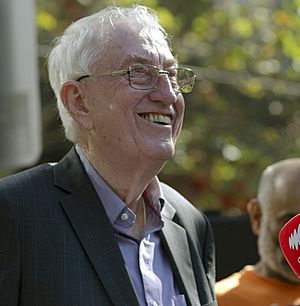Peter Doherty (immunologist) facts for kids
Quick facts for kids
Peter Doherty
|
|
|---|---|
 |
|
| Born |
Peter Charles Doherty
15 October 1940 (age 85) Brisbane, Queensland, Australia
|
| Education | |
| Known for | Major histocompatibility complex |
| Awards | Paul Ehrlich and Ludwig Darmstaedter Prize (1983) Nobel Prize in Physiology or Medicine (1996) Australian of the Year (1997) Leeuwenhoek Lecture (1999) |
| Scientific career | |
| Fields | Medicine Immunology |
| Institutions | John Curtin School of Medical Research Australian National University Trinity College Dublin |
| Thesis | Studies in the experimental pathology of louping-ill encephalitis (1970) |
| Doctoral advisor | G. L. Montgomery J. T. Stamp |
Peter Charles Doherty (born 15 October 1940) is an Australian immunologist. He won the Nobel Prize in Physiology or Medicine in 1996.
Dr. Doherty shared the Nobel Prize with Rolf M. Zinkernagel for their important discoveries about the immune system. He was also named Australian of the Year in 1997. This award recognized his amazing work. In 1997, he received the Companion of the Order of Australia. This is a high honor for his contributions to science. He is also known as an Australian Living Treasure.
In 2009, his research on the immune system was celebrated as one of Queensland's top "innovations and inventions." In 2012, Dr. Doherty became an Honorary Professor at Trinity College Dublin in Ireland.
Contents
Early Life and Education
Peter Charles Doherty was born in Brisbane, Australia, on October 15, 1940. He grew up in Oxley. He went to Indooroopilly State High School, which now has a lecture hall named after him.
In 1962, he earned a bachelor's degree in veterinary science from the University of Queensland. He worked as a vet for a while. Then, he started laboratory work at the Animal Research Institute. There, he met Penelope Stephens, a microbiology graduate. They got married in 1965. Peter Doherty received his master's degree in veterinary science in 1966.
He then went to Scotland and earned his PhD in pathology in 1970 from the University of Edinburgh. After that, he returned to Australia. He continued his research at the John Curtin School of Medical Research in Canberra.
Understanding the Immune System
Dr. Doherty's research focused on how our bodies fight off diseases. His Nobel Prize-winning work explained how our immune cells protect us from viruses. He and Rolf Zinkernagel discovered how special immune cells, called T cells, recognize infected cells.
Viruses infect our cells and make copies of themselves inside. Killer T-cells are like tiny soldiers that destroy these infected cells. This stops the viruses from spreading. In their important studies, Doherty and Zinkernagel found something amazing. A T-cell can only recognize an infected cell if it sees two things at once. First, it needs to see a tiny piece of the virus. Second, it needs to see a special "self" molecule. This molecule is called a major histocompatibility complex (MHC) protein. It's like a secret handshake that tells the T-cell, "This is one of our body's cells, but it's infected!"
Scientists already knew that MHC proteins were important for organ transplants. They caused the body to reject new organs if they weren't a good match. Doherty and Zinkernagel discovered that MHC proteins are also key for fighting off viruses, like those that cause meningitis viruses.
Awards and Recognition
Dr. Doherty has received many honors for his scientific work. In 1987, he became a Fellow of the Royal Society (FRS). This is a very respected scientific group. In 1997, he received the Golden Plate Award from the American Academy of Achievement.
He is also the patron of the Peter Doherty Institute for Infection and Immunity. This institute, located in Melbourne, Australia, brings together experts to fight infectious diseases. It opened in 2014. In 2015, he became an Honorary Fellow of the Academy of Medical Sciences. He was also elected a Fellow of the Australian Academy of Health and Medical Sciences in the same year. In 2017, he became a Fellow of the Royal Society of Victoria.
Several schools have named houses after him. These include John Monash Science School, Moreton Bay Boys College, and Murrumba State Secondary College.
Personal Life
As of 2021, Peter Doherty and his wife, Penny, live in Melbourne, Australia. They have two sons. Michael is a neurologist in the United States. James is a lawyer in Melbourne. They also have six grandchildren.
In 2020, during the COVID-19 pandemic, Dr. Doherty became famous in a funny way. He accidentally tweeted "Dan Murphy opening hours" instead of searching for it online.
Dr. Doherty spends part of the year doing research at St. Jude Children's Research Hospital in Memphis, USA. He is also a faculty member at the University of Tennessee Health Science Center. For the rest of the year, he works at the University of Melbourne in Australia.
See also
 In Spanish: Peter C. Doherty para niños
In Spanish: Peter C. Doherty para niños

